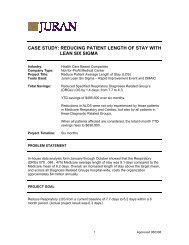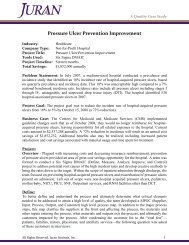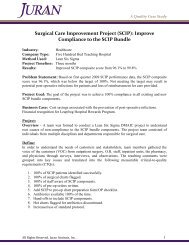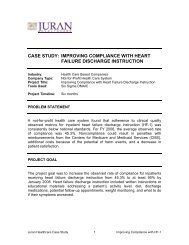Case Study Timely Diagnosis of Breast Cancer.pdf
Case Study Timely Diagnosis of Breast Cancer.pdf
Case Study Timely Diagnosis of Breast Cancer.pdf
You also want an ePaper? Increase the reach of your titles
YUMPU automatically turns print PDFs into web optimized ePapers that Google loves.
• Reduced cost per exam through improved scheduling efficiency<br />
• Reduced dollars paid in overtime, which sometimes run high because <strong>of</strong> a<br />
schedule that under-anticipates mammography volume<br />
• Increased diagnostic and surgical volume for breast cases, resulting in increased<br />
revenue<br />
• Adjusted pricing and established pr<strong>of</strong>it margin for digital mammograms, resulting<br />
in increased revenue<br />
PROJECT<br />
Overview<br />
The hospital’s leadership selected a core, multidisciplinary project team to analyze the<br />
reasons for delays in communication <strong>of</strong> the diagnosis and recommend improvements to<br />
reduce the number <strong>of</strong> “sleepless nights.” In addition, the core team identified a support<br />
team to serve as a resource to the project which consisted <strong>of</strong> physicians, diagnostic<br />
imaging staff, transcription, scheduling, finance, and information services.<br />
The project scope included all process steps to diagnose a suspicious breast lesion for<br />
women with a new onset <strong>of</strong> suspicion and for women with a previous incident <strong>of</strong> breast<br />
cancer. This included imaging studies to diagnose a suspicious breast lesion such as<br />
mammogram, ultrasound, radiological biopsy, and surgical biopsy. The communication<br />
processes for these studies, such as all pathology and radiology medical reports,<br />
appointment scheduling, and communication <strong>of</strong> results, was also included. The project<br />
did not include an examination <strong>of</strong> the full radiologist workflow. Situations in which the<br />
diagnostic process was aborted for any reason were not included in the project.<br />
DMAIC Process<br />
The team selected the DMAIC process as its improvement method. A Six Sigma<br />
DMAIC project is defined as a project that eliminates a chronic problem that is causing<br />
patient dissatisfaction, defects, costs <strong>of</strong> poor quality, or other deficiencies in<br />
performance.<br />
Current Process Capability<br />
• Using data from a physician self-report survey (n=38), the hospital determined<br />
that the median number <strong>of</strong> days women waited to hear the results <strong>of</strong> their<br />
diagnostic procedure was three days. The team considered anything over two<br />
days a defect, which generated a short term sigma level for this process <strong>of</strong> 1.37<br />
with a DPMO <strong>of</strong> 552,632.<br />
• Using data from a comprehensive 30-month chart review (October 2004 to April<br />
2007), the hospital outlined its current process capability from the number <strong>of</strong><br />
days a suspicious lesion was identified to results <strong>of</strong> the diagnosis received. The<br />
median was 18 days. The short term sigma level for this process was 0.47 with<br />
DPMO at 847,909.
















